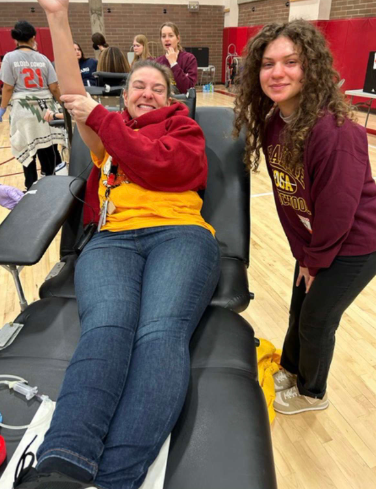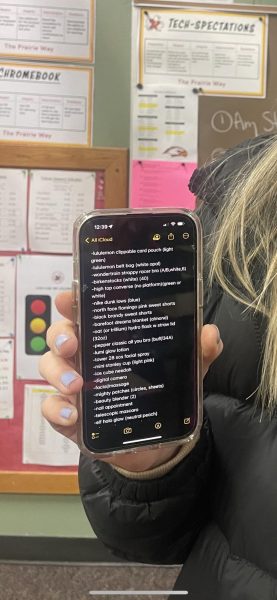Teenagers May Be at Great Risk When Giving Blood

Mrs. Thompson donating blood with Melody Brizuela.
If your child is in or going into high school, a new situation may present itself: donating blood. As students from ages 16-18 are able to enter blood drives, teens and parents may want to stay informed on the reality of donating blood and the new guidelines that have been put into place.
Although teenagers have shown a great amount of blood supply contributions, they are also at a large risk of immediate reactions and health risks. While 16-17-year-olds only make up 2.8% of our entire population, they are showing an estimated 10% of contributions to the blood supply. Due to this, there are many positives to blood drives coming into high schools. But is this selfless act worth the health risk we put on some kids?
A major effect on teenagers that comes with donating blood is physical effects such as fainting and dizziness. These side effects can lead to larger injuries such as head injuries, facial lacerations, and fractures due to falls. It is estimated that 5000 students will lose consciousness along with 600 receiving injuries due to blood donation each year. Although Blood Centers have to conform to federal regulations, these regulations may not be enough in a high school. Teenagers are still growing and developing and this could cause these complications to be more significant on their health.
Another issue with blood drives entering schools is the absence of parents. Many teenagers don’t always communicate to their parents what they are involved in at school. With 37 states allowing 16-year-olds to donate blood, and five of those States not requiring parental consent, this can lead to many parents being unaware. Students may feel pressured to donate by their peers and if they aren’t forced to they choose to leave their parents out of it. This is where the conversation of raising the minimum donation age has arisen. Data shows that 16-year-olds are not needed to keep an adequate blood supply, so eliminating them completely from blood donation should cause no harm. But while we keep 17 and 18-year-olds in the picture, schools should still require a parental consent form if the donation is being done through them.
Prairie High School HOSA has been in the running for one of the best blood drives in the Vancouver area.
“The Red Cross can’t speak highly enough about how amazing this community is to them,” says Melissa Levine, leader of Prairie’s HOSA. Levine has seen her fair share of reactions herself in schools, but this doesn’t mean it’s due to drives being held in schools.
“It’s pretty even across the board (between blood centers and high schools) but it’s more emphasized at high school drives because you don’t leave and go home,” says Levine.
Blood center donations allow you to leave but when you are donating at school and have to go to class the rest of the day, this allows for people to witness the reactions teens may have. Although these risks may occur, overall Levine feels that blood drives are good to have in high schools for many reasons such as getting involved with the community and learning more about health.
When randomly interviewing a variety of students (from freshmen to seniors) at Prairie High School, different opinions and responses were heard about the blood drive that takes place multiple times a year.
“I love giving blood and saving lives, ” says senior Ruby Morningstar. But while she loves to do it and help, she also has witnessed many people have some serious reactions at school. Along with junior Hannah Huber, Huber has also seen her classmates have some type of reaction after giving blood. But this won’t stop her and neither will her hemoglobin test.
One good precaution taken by the Red Cross is testing the student’s hemoglobin before donation, and while Hannah failed the last time she tried to donate, she hopes to return for another try in the future as she feels “inspired to help others,” says Hannah.
In a poll of 50 kids who donated blood at Prairie, 44% of them experienced a reaction such as passing out or feeling sick. With barely less than half of the kids feeling this way after donating blood, this number could potentially be greatly decreased in schools like Prairie around the globe if we give this topic more attention. The more this is taken seriously, the more we will hear and see a response to this issue and an improvement in safety.
Prairie High School alone has seen almost half of its donors experience some type of reaction due to the donation, and other schools around the globe are likely experiencing this as well. If we take more precautions such as raising the age and keeping parents informed, we could potentially help kids have a safer and healthier experience. We want to keep these incredible selfless acts of kindness in schools to help ensure a stable blood supply, but we want to do so safely.







